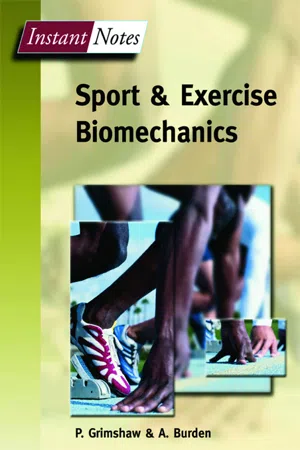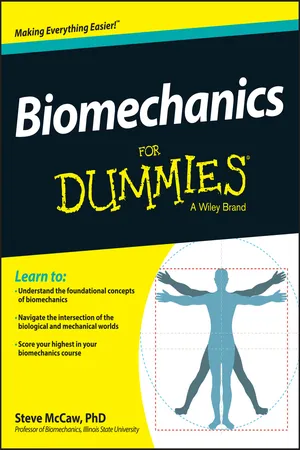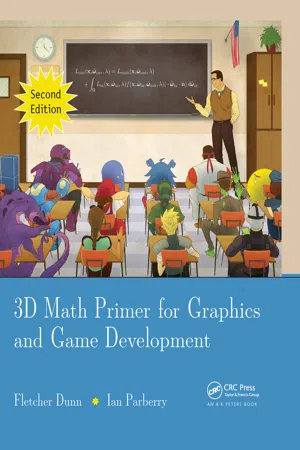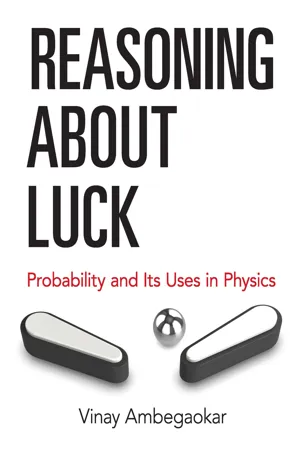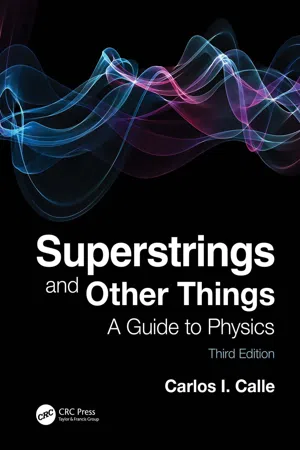Physics
Newton's Second Law in Angular Form
Newton's Second Law in Angular Form states that the torque acting on an object is equal to the product of the object's moment of inertia and its angular acceleration. Mathematically, it is expressed as τ = Iα, where τ represents torque, I is the moment of inertia, and α is the angular acceleration. This law describes the relationship between the forces and torques acting on rotating objects.
Written by Perlego with AI-assistance
Related key terms
10 Key excerpts on "Newton's Second Law in Angular Form"
- Paul Grimshaw, Neil Fowler, Adrian Lees, Adrian Burden(Authors)
- 2007(Publication Date)
- Routledge(Publisher)
Angular impulse = Change in angular momentum). This has very important implications within human movement and is applicable in many examples within sport where the athletes use angular momentum and rotational movements to generate both linear and angular velocities. For example, the rotational component used by modern javelin throwers; the rotational running across the circle technique used in discus throwers; the golfer using rotational movements of hips and shoulders to generate torque that is transferred to the club to accelerate it quicker; and the tennis player serving with rotational movements about the longitudinal axis in order to impart large amounts of spin and velocity to the ball. All these examples and more utilize the angular analog of Newton’s second law of motion.Newton’s third law of motion
In linear terms this law is stated as follows:Whenever an object exerts a force on another there will be an equal and opposite force exerted by the second object on the first.In angular terms this can be re-written as follows:Whenever an object exerts a torque on another there will be an equal and opposite torque exerted by the second object on the first.In the angular analog of this law the term force has been replaced by the term torque. Torque as we know is a turning or twisting moment which causes an angular acceleration of an object. In the context of this third law of motion it is important to remember (as with the linear version) it is the forces or torques that are equal and opposite and not the net effect of the forces or torques. The equal and opposite torques will act on each body differently (because the two bodies are different) and they will both act about the same axis of rotation. As with the linear analog of this law of motion it is important to remember the consideration of external and internal force or torque. If the body is in equilibrium (when the algebraic sum of all the torques acting is zero) under the action of external torque both the external and internal torque systems are separately in equilibrium. In considering the net effect of external torques or forces acting on a body we would summate only the external torques that are acting on that body. Hence, if body A exerts an external force or torque on body B, body B will exert an external reaction force or torque on body A. However, in considering the net effect on body B we would only consider the external forces or torques acting on body B (which is the external force or torque provided from body A – this is of course ignoring any other external forces such as gravity).In the case of the arm inFig. C2.5which is undergoing a flexion movement (an anti-clockwise rotation of the lower arm (the forearm)) the torque created by the biceps brachii muscle exerts a torque on the lower arm. This torque causes the lower arm to rotate in an anti-clockwise direction. The reaction torque to this will be a torque in the opposite direction created on the upper arm. As the torque is applied to the arm (to accelerate it anti-clockwise) there will be an equal and opposite torque acting on the upper arm. This is why when you conduct an arm curl during weightlifting you can feel the stress/strain in the upper arm. Because the torques are equal and opposite and act independently on two different bodies (the torque of the biceps acts on the lower arm (anti-clockwise) and the reaction torque acts on the upper arm and the net result is zero (equal and opposite torques)) but movement takes place because the torque acting on the lower arm is considered as an external torque acting on that body (Newton’s second law). As we have seen this movement is dependent upon the moment of inertia of the object. The torque created is dependent upon the force applied and the moment arm at which the force is applied (the perpendicular distance from the axis of rotation). The angular analog of Newton’s third law has important implications with human movement and in particular for consideration of injury.Fig. C2.6- eBook - ePub
- Steve McCaw(Author)
- 2014(Publication Date)
- For Dummies(Publisher)
The two main points to remember in looking at Newton's laws for angular motion are that the moment of inertia — the resistance to changing angular motion — is not necessarily constant for a body, and a force must have a moment arm to produce a turning effect on a body. In the following sections, I explain Newton's laws of angular motion.Maintaining angular momentum: Newton's first law
Newton's first law, also known as the law of conservation of angular momentum, specifies that an unbalanced external torque causes a change in the angular momentum of a body. Angular momentum is the product of the moment of inertia (I ) and the angular velocity (ω), or H = I ω (as explained earlier). According to Newton's first law:A body will continue to rotate about its axis of rotation with a constant value of angular momentum unless acted on by an unbalanced external torque.The H of a rotating body stays constant in the absence of an unbalanced external torque. But the angular motion of a rotating body can change without an external torque.Angular motion is a description of how fast and in what direction a body is rotating, its angular velocity (ω). The resistance to changing angular motion is the moment of inertia (I ). Even though H = I ω stays constant without an external torque, because I can be changed by repositioning the mass around an axis of rotation, the angular velocity of a body can change even without an unbalanced external torque. This is different from the linear situation, where a body accelerates, or speeds up or slows its linear motion, only because of an unbalanced external force; the mass stays constant.The angular velocity (ω) of a body does not have to stay constant in the absence of an unbalanced torque. It's the angular momentum (H ), the product of the moment of inertia (I ) and the angular velocity (ω), that is conserved in the absence of an unbalanced torque.Some of the clearest examples of Newton's first law for angular motion come in events that include one or more total-body rotations while the performer is in the air. Diving is an example. Figure 10-3 shows a diver's body positions at several points during the performance of a one-and-one-half front somersault, from when the diver leaves the board (a) until the diver's hands contact the water (f). Below the body positions, I've plotted out the diver's momentum (H ), moment of inertia (I - No longer available |Learn more
- Robert A. Pelcovits, Joshua Farkas(Authors)
- 2023(Publication Date)
- Barrons Educational Services(Publisher)
rα, which is valid in the case of a pulley if the string does not slip over the pulley.TIPThe tension in the string on either side of a pulley is not the same when we include the mass of the pulley.Caution: When solving a pulley problem taking into account the rotation of the pulley (and thus its mass), the tension in the string is not the same on either side of the pulley as it was when we neglected the mass of the pulley. If it were, there would be no net torque on the pulley (the two forces of tension on either side of the pulley would exert equal and opposite torques), and the pulley would not rotate.CHAPTER SUMMARYThe angular position, velocity, and acceleration of a rigid body rotating about a fixed axis can be defined in analogy to the translational quantities defined in Chapter 2 . If the rotational acceleration is constant, these definitions yield equations for the angular position and velocity analogous to those in Chapter 2 for UAM. By examining the kinetic energy of a rotating object, the rotational analog of mass, the rotational inertia, can be defined. The rotational analogs of Newton’s second law, work and power, all take the forms expected by straightforward analogies.1 One revolution corresponds to a complete circle. Because the circumference of a circle is 2πr, the number of radians in a circle is θ = arc length/radius = 2πr/r = 2π.2 Recall the definition of rotational inertia as I = ∫r2 dm. For a point particle, all the mass is the distance r from the axis of rotation so that I = ∫r2 dm = r2 ∫dm = mr2 - eBook - ePub
Doing Physics with Scientific Notebook
A Problem Solving Approach
- Joseph Gallant(Author)
- 2012(Publication Date)
- Wiley(Publisher)
When there is no net force acting on the object, there is no change in the object’s velocity. If it is at rest, it remains at rest. If it is moving, it keeps moving at constant velocity. Since velocity is a vector, constant velocity means no change in both speed and direction. Motion at constant velocity is motion in a straight line at a constant speed.The First Law is actually a definition of inertia, the tendency of an object to maintain its current state of motion. The object’s motion remains unchanged unless a non-zero net force acts on it. The First Law also explains the reason for wearing a seat belt. A seat belt attaches you to the car’s brakes. The brakes stop the car, but anything not attached to the car keeps going with its initial speed and direction until something stops it.Newton’s Second Law for Constant Forces
The First Law tells us what happens when there is no net force. The Second Law tells us what happens when there is a net force.Newton’s 2nd Law: The acceleration produced by a net force acting on an object is proportional to the net force, inversely proportional to the mass of the object, and is in the direction of the net force.The traditional way to write the Second Law is that the net force equals mass times acceleration.(5.1)A non-zero net force causes certain changes in the object’s motion, and the Newton’s Second Law allows us to calculate the effects of those changes. It is a recipe for calculating the effect - an acceleration - from the causes of the change in motion - a non-zero net force. This is a vector equation; the Second Law relates each component of the net force to the corresponding component of the acceleration.(5.2a)(5.2b)To understand the cause-and-effect relationship between the net force and the acceleration, it is helpful to rearrange Newton’s Second Law.The metric unit of force is the newton (N) and the American unit of force is the pound (which SNB denotes as lbf).The newton is a derived unit where 1 N = 1 kg m/s2 - eBook - ePub
- Fletcher Dunn, Ian Parberry(Authors)
- 2011(Publication Date)
- A K Peters/CRC Press(Publisher)
tried , and therefore do not atomize our planet. We are quite fond of it.In summary, if a reference frame is accelerating or rotating, the motion of objects described using that reference frame will not be consistent with mechanical laws. An inertial reference frame must be stationary or moving at a constant linear velocity.12.1.3 Newton’s Third Law
Newton’s third law is often misunderstood in spite of being the one most often quoted. It has a certain zen-like justice to it.5Newton’s Third Law To every action there is always an equal and opposite reaction. Or, the forces of two bodies on each other are always equal and are directed in opposite directions.This law basically says that there is no such thing as a single unilateral force. If object A pushes or pulls on object B , then object B always pushes or pulls back on object A with a force of the same magnitude but opposite direction. If gravity is pulling me towards Earth, it’s also pulling Earth towards me! A force is always part of an interaction between two bodies.In diagrams, we often draw a force as an arrow, since it is a vector. But really, these diagrams would be more accurate if both ends of the arrow had arrowheads. When we leave off the other side of the arrow, it’s because it is acting on an object in which we have no interest. When you see a single-sided arrow that represents a force in a diagram, you can always fill in the other half in your mind.One source of misunderstanding of Newton’s third law is the word “reaction.” The purpose of this word is to describe the forces as being in opposition to one another. It is not meant to imply a causal link between them; neither force is a “cause” or “effect.” The two opposing forces act simultaneously and, so far as the laws of physics are concerned, have equal status. - eBook - ePub
Engineering Science
For Foundation Degree and Higher National
- Mike Tooley, Lloyd Dingle(Authors)
- 2013(Publication Date)
- Routledge(Publisher)
In this chapter we have reviewed or introduced a number of fundamental dynamic principles that will act as a foundation for further study of dynamics and will be useful, in their own right, during your study of engineering science. We started by reminding ourselves of some fundamental definitions that were necessary in order to fully understand the nature of Newton’s laws, which are used as the foundation of classical mechanics. From Newton’s laws, the linear equations of motion were derived, both graphically and analytically, and through use of the transformation equation the equations for angular motion were also found and then applied to simple engineering problems that also required knowledge of torque, moment of inertia and the radius of gyration.In section 8.4 we considered friction and started by studying the ‘laws’of friction, which have been found by experiment to model the behaviour of differing materials in contact subject to differing external conditions. We then used space diagrams to show the nature of all the forces acting on a body, together with analytical and vector-drawing resolution of forces, in order to solve simple engineering problems involving friction.Section 8.5 was devoted to energy transfer, in particular to the various forms of mechanical energy and its conservation, where we covered work done, potential energy, strain energy (internal potential energy) and kinetic energy and their relationship to the dynamic behaviour of vehicles and bodies. The concepts and simple engineering applications associated with linear and angular momentum were introduced in section 8.6, including the relationship between rotational kinetic energy and angular momentum of rotating machines. Section 8.7 was given over to a very short study of power and power transmitted by a torque, again with reference to rotating machines.Finally, in section 8.8, we looked at circular motion as a particular type of angular motion and considered the acceleration and forces that act on vehicles in circular motion, in particular, the conical pendulum, aircraft in turning flight and cyclists rounding bends in a circular path. This summary does not contain information related to the derivation or use of individual formulae, as it is felt that you will have met the majority of these formulae before and will be able to consolidate your understanding by attempting the practice review questions that follow. - eBook - ePub
- Vinay Ambegaokar(Author)
- 2017(Publication Date)
- Dover Publications(Publisher)
Suppose that an object is moving steadily around a circle of radius one meter at such a rate that it makes one circuit in 2 π seconds, i.e. approximately 6.28 seconds. Then, using (6.6), we find that its acceleration towards the center is one mks unit – one meter/(second) 2. If the object has a mass of one kilogram, Newton’s second law then informs us that this requires a steady force pulling it towards the center of one mks unit of force, or one newton. The one other situation I would like to explain is easier to understand : constant acceleration in the direction of the velocity. This is, approximately, what happens when an object is dropped from a window. [Approximately because the gravitational force is not the only force acting on such a falling object; there is air resistance as well.] The force of gravity is proportional to the mass of the object; this force causes all bodies falling near the surface of the earth to accelerate downward at the same rate, which in mks units is approximately 9.81 m/ s 2. An object released from rest thus picks up downward velocity as it accelerates. The ubiquity of frictional forces opposing motions in our everyday world makes it easy to understand why astronomical observations played such an important role in the insights of Newton and his contemporaries. On the other hand, although the original impetus for the development of mechanics may have been the explanation of celestial motions, one of Newton’s great triumphs was the unification of celestial and terrestrial dynamics. We are very close to being able to understand this synthesis. What follows is a small digression in that direction - eBook - ePub
Newtonian Dynamics
An Introduction
- Richard Fitzpatrick(Author)
- 2021(Publication Date)
- CRC Press(Publisher)
Nowadays, Newton’s first law strikes us as almost a statement of the obvious. However, in Galileo’s time, this was far from being the case. From the time of the ancient Greeks, philosophers—observing that objects set into motion on the Earth’s surface eventually come to rest—had concluded that the natural state of motion of objects was that they should remain at rest. Hence, they reasoned, any object that moves does so under the influence of an external influence, or force, exerted upon it by some other object in the universe. It took the genius of Galileo to realize that an object set into motion on the Earth’s surface eventually comes to rest under the influence of frictional forces, and that, if these forces could somehow be abstracted from the motion then the motion would continue forever.4.3 Newton’s Second Law of Motion
Newton used the word “motion” to mean what we nowadays call momentum. The momentum, p, of a body is defined as the product of its mass, m, and its velocity, v; that is,Newton’s second law of motion is summed up in the equationp = m v .(4.2)(4.3)= f ,d pd twhere the vector f represents the net influence, or force, exerted on the object, whose motion is under investigation by other objects in the universe. For the case of a object with constant mass, the previous law reduces to its more conventional formm a = f .(4.4)In other words, the product of a given object’s mass and its acceleration,a = d v / d t, is equal to the net force exerted on that object by the other objects in the universe. Of course, this law is entirely devoid of content unless we have some independent means of quantifying the forces exerted between different objects.4.4 Measurement of Force
One method of quantifying the force exerted on an object is via Hooke’s law. (See Section 5.6 .) This law—discovered by the English scientist Robert Hooke in 1660—states that the force, f, exerted by a coiled spring is directly proportional to its extension,Δ x - eBook - ePub
Superstrings and Other Things
A Guide to Physics
- Carlos I. Calle(Author)
- 2020(Publication Date)
- CRC Press(Publisher)
different bodies, the pavement and the wheels.Newton’s third law tells us that forces always come in pairs, acting on different bodies. A single isolated force acting on a body without another equal force acting somewhere else cannot exist.According to the third law, the force that keeps the moon orbiting around the earth, F EM , is equal and opposite to the force that attracts the earth toward the moon, F ME (Figure 3.10 ). The force of attraction between the earth and any object is called the weight of the object, w . If we drop a ball near the surface of the earth and neglect air resistance, the force of attraction between the earth and the ball makes the ball fall toward the center of the earth with an acceleration of 9.8 m/s2 , which is, as we learned in Chapter 2 , the acceleration due to gravity, g . Newton’s second law tells us that this force due to gravity or weight (w ) is given byw = m gFIGURE 3.10 The earth and the moon attract one another with equal and opposite forces.where m is the object’s mass. The third law tells us that the object pulls on the earth with an equal and opposite force. Thus, the ball pulls on the earth with a force equal in magnitude to its weight (Figure 3.11 ). Newton’s second law also explains why the acceleration at which the earth “falls” toward the ball is negligibly small, since the force exerted by the ball on the earth is equal in magnitude to the ball’s weight. Therefore,FIGURE 3.11 The earth pulls on the falling ball with a force that we call the ball’s weight. The ball pulls on the earth with an equal and opposite force.F = w =M Ea = m g .Since M e is much greater than m , a must be much smaller than g .Any two objects interacting with each other obey Newton’s third law. The two skaters of Figure 3.12 - eBook - ePub
- A. L. Stanford, J. M. Tanner(Authors)
- 2014(Publication Date)
- Academic Press(Publisher)
Newton’s second law, Σ F = m a, incorporates the fact that a static body, since it is not moving and therefore has no acceleration, has no net force acting on it. This is a condition of static equilibrium. We now know, however, that a body may have a net force equal to zero yet may not be static; it may, in fact, be undergoing rotation (look at Figure 4.14[a], for example). Consequently, for a body to be in static equilibrium, we must impose an additional condition: The net torque on the body must be zero. Here we may ask, “About what axis should the torques on the body be calculated? About what axis is the net torque equal to zero?” These questions may be answered by a question, “About what axis is the body not rotating?” Clearly, if the body is static, it is not rotating about any axis. Therefore, the net torque on a static body caused by all the forces on that body must be equal to zero when calculated using any axis. This condition, which pertains to any axis, may be expressed by Σ τ = 0 (4-33) (4-33) This means that, for any given arbitrary axis, all the forces acting on a body in static equilibrium produce torques about that axis, the magnitudes of which sum algebraically to zero. An astute reader could ask about a body in static equilibrium, “How do 1 know that if the torques sum to zero about a given axis and the forces sum to zero, the torques will sum to zero about any other axis?” We have not addressed this point, but Problem 4.47 provides the opportunity to convince yourself of its validity. A body in static equilibrium, then, is subject to two conditions of equilibrium, both of which must be satisfied
Index pages curate the most relevant extracts from our library of academic textbooks. They’ve been created using an in-house natural language model (NLM), each adding context and meaning to key research topics.
